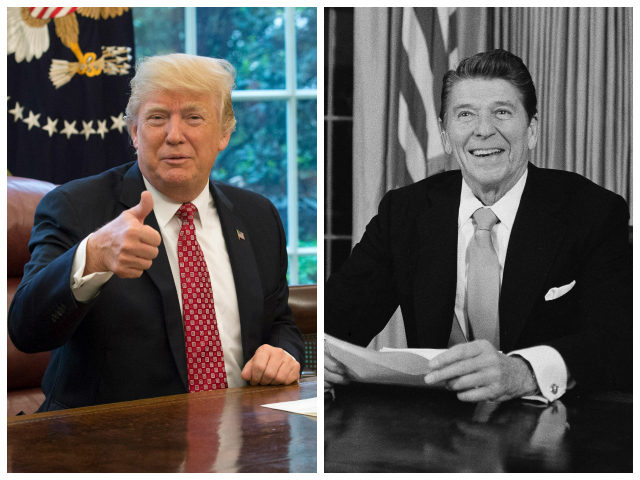What they say about the weather is also true of politics: If you don’t like what’s happening now, wait a bit—because things will change.
The same point holds true for presidential politics. Presidents are sometimes up, and they’re sometimes down—except when they’re in between.
Moreover, there’s a lot of resilience in the presidency, because presidents are elected to a four-year term, and the reality of a fixed term prevents the sort of rapid-fire rise-and-fall sometimes seen in parliamentary systems. In Italy, for example, the government has changed 68 times since World War Two. By contrast, here in the U.S., we’ve seen just 12 presidents.
Speaking of resilience, I was myself a minor participant in an epic presidential comeback; in the early 1980s, I was working as a low-level aide in the Reagan White House—and early on, the administration took a skid.
In May 1981, the administration proposed a sharp cut in Social Security benefits. This was at a time when the system was in crisis; indeed, in those days, many Democrats in Congress thought that significant changes, including at least some cuts, needed to be made. Still, the Reagan proposal, rushed out without adequate vetting and proposing big cuts, was ill-received, to put it mildly.
On May 20, 1981, the U.S. Senate, controlled by Republicans, voted 96:0 to reject Reagan’s cuts. This vote was a big deal, sending political shockwaves across the nation. The New York Times referred to it as “Mr. Reagan’s first big political blunder.” And the Associated Press added: “The Senate delivered a unanimous jolt to Reagan’s Social Security proposals by voting against ‘precipitous and unfair’ cuts.”
Indeed, in a parliamentary system, it’s possible that the government would have fallen in the wake of such a negative vote. Yet the U.S. doesn’t have a parliamentary system, and Reagan was still president.
Still, the severe repercussions continued; the voters had been rattled by the prospect of sudden cuts in the popular retirement system. A month later, in June, Reagan’s Republican Party had a bad scare in a special election in a presumed safe seat in Ohio. GOPer Mike Oxley won the special election in Ohio’s fourth Congressional district by a scant .3 percent—this being a district that the previous GOP incumbent had won just seven months earlier by a whopping 44 points. (Oxley went on to win another dozen elections to the House, none of them as close as that first one.)
Yet for his part, President Reagan had learned a lesson. But he was nevertheless determined to fulfill his mandate from the 1980 election; he had a bold agenda, and he couldn’t wait to advance it.
But first, he had to move the Social Security issue offstage; he worked with Congressional leaders in both parties to set in motion a bipartisan commission to study the future of that entitlement program—the so-called Greenspan Commission, which released its report a full two years later.
Then, with that sticky wicket in the rearview mirror, the 40th president moved forward. On July 31, the same Senate that had voted “nay” by such a big margin on Social Security turned around and voted “aye” on his bold tax-rate-reduction plan.
Next, on August 13, the Gipper signed the Economic Recovery Tax Act (known to history as Kemp-Roth) into law.
Even so, despite that massive success, Reagan wasn’t out of the woods; the economy, after all, was still suffering from the hangover of the “stagflation” of the 1970s. And yet now, it was “Reaganomics” that was getting the blame.
After the 1982 midterms, in which Republicans suffered big losses in Congress, The New York Times ran a lead editorial proclaiming, “The stench of failure hangs over Ronald Reagan’s White House.”
In addition to the brickbats from the media, the polling, too, was negative. In January 1983, a Gallup Poll found that Reagan was losing, badly, in hypothetical presidential matchups against Democrats; he was down a full 12 points to Walter Mondale, who was, in fact, the future Democratic presidential nominee.
Yet soon, the good effects of Reagan’s economic agenda were starting to be felt: Just as the President had predicted, the sun came out, and the economy came roaring back in 1983 and 1984. And so Reagan—who not long before had been written off as a loser—won his ’84 re-election bid by 18 points, carrying 49 of the 50 states.
So there you have it: What happens to a president early on is not automatically dispositive to what happens to that president later on. (And yes, inside the White House, it felt like a roller coaster—a bit scary at times, but then, ultimately, exhilarating.)
In fact, if we look back into U.S. history, we see many other presidential precedents that prove the same point. The armies of President Abraham Lincoln, for example, suffered defeat after defeat in the early years of the Civil War, leading many to question Lincoln’s leadership. Yet by November 1864, the situation had turned around, and the Union forces were winning; Lincoln was re-elected in a landslide, winning 22 of 25 states.
More recently, President Harry Truman, assuming office in 1945, found his administration rocked by a series of reverses, including the massive defeat of his party in the 1946 midterm elections; the Democrats lost control of both chambers for the first time in nearly 20 years. And yet Truman hung in there; he rallied his forces in the 1948 election, and then, in the final campaign, he gave ‘em hell. As a result, not only was he elected to a second term, but his party won back the Congress. To this day, Truman is the patron saint of presidential underdogs.
Admittedly, it’s easier to recall the past than it is to predict the future. And yet all history speaks loudly to the basic wisdom known by every sports fan: It ain’t over till it’s over.

COMMENTS
Please let us know if you're having issues with commenting.